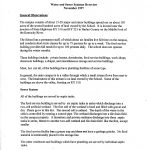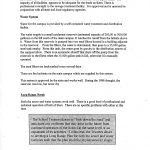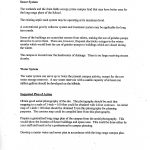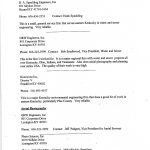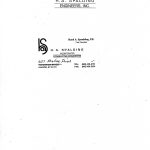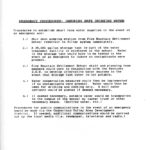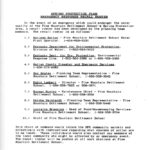Pine Mountain Settlement School
Series 12: LAND USE
1997-1998 Water Protection Plan
Water and Sewer Systems Overview November 1997
Emergency Procedures 1998
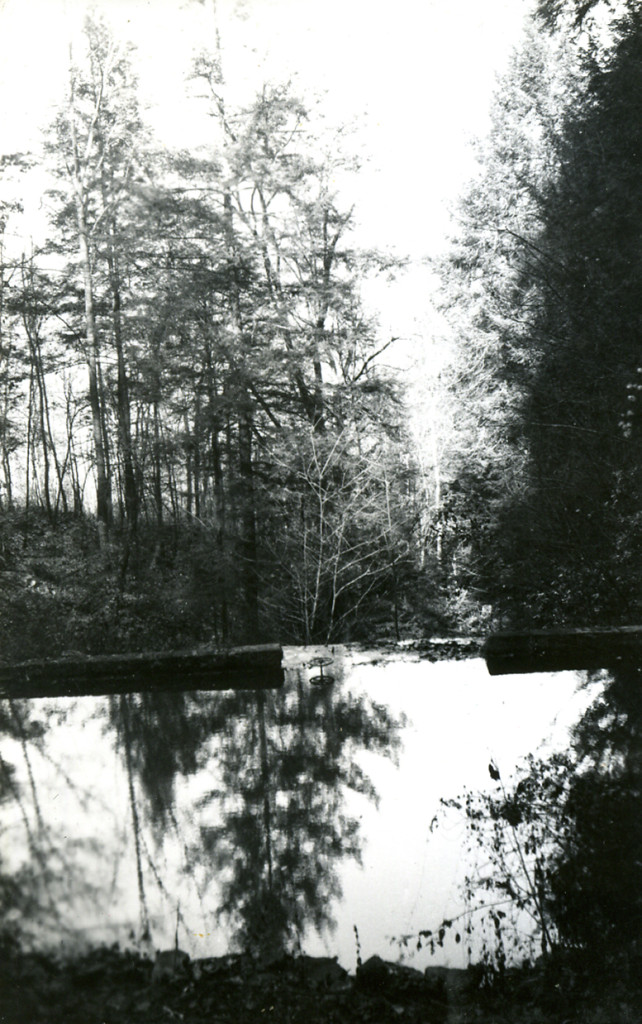
Reservoir. Photo by Sally Loomis, 1930. [nace_1_054a.jpg]
TAGS: Land use, 1997, water protection plans, Robin Lambert, reservoir, sewer systems, water systems, description of PMSS campus, septic tanks, wetlands, drain fields, long-range plans, aerial photography, engineering firms, emergency procedures, recall roster, Mildred Mahoney, Robin Lambert
LAND USE 1997-1998 Water Protection Plan
HISTORY: Water Protection Plan
Water. Clean water. And plenty of it is a necessary requirement of habitation. One of the first considerations in looking at the land for the new Pine Mountain Settlement School was the question of sufficient sources of potable water. The next requirement was to make the water accessible to the School.
In 1916, the construction of a new reservoir was immediately undertaken and plans were made for the delivery of water to the critical buildings on the campus. By the second decade the concern shifted to maintenance of the water supply for the School and several varieties of “water protection plans” were drafted.
The following overview (November 1997) and emergency procedures (1998) are examples of such plans in which the current water resources are reviewed and a strategy for their protection is outlined.
TRANSCRIPTION: 1997 Water-Sewer Overview
November 1997
General Observations
The campus consists of about 15-20 major and minor buildings spread out on about 150 acres of the several hundred acres of land owned by the School. It is located near the junction of State Highways KY 510 and KY 221 in Harlan County on the Middle Fork of the Kentucky River.
The School has a permanent staff, of which about six families live full time on the campus, and conducts short-term classes for up to 75 persons for up to a week. The food service building provides full meals for up to 100 persons daily. The school does not operate during the winter months.
These buildings include: private homes, dormitories, food service buildings, work shops, classroom buildings, a chapel, and miscellaneous storage and service buildings.
Most, but not all, of the buildings have plumbing facilities of some type.
In general, the main campus is in a valley through which a small stream flows from east to west. The headwaters of this stream is on land owned by the School. Some of the buildings are above the valley, fronting on KY 510.
Sewer System
All of the buildings are served by septic tanks.
The food service building is served by six septic tanks in series which discharge into a two-cell artificial wetland. The first cell of the wetland is lined and filled with gravel and dirt. Plants grow in this dirt. The second cell is unlined. The depth of the water in the cells is controlled by rotating a control pipe. The wetland discharges into a tile drain field on the campus property. A dormitory and private residence discharge into three septic tanks in series, thence to another two-cell wetland and tile drain field like the first, except smaller.
The food service facility has a grease trap and does not have a garbage grinder. No food material is intentionally placed in the sewage line.
The other residences and buildings which have plumbing are served by individual septic tanks.
water_sewer_overview_002
All of the sewer systems work well. There are no odor problems any time of the year from either the wetlands or the drain fields or any of the individual septic tanks. The capacity of all facilities appears to be adequate for the loads on them. There is professional oversight to the sewage treatment facility. It is approved and is operated in conjunction with all state and local regulatory agencies.
Water System
Water for the campus is provided by a self contained water treatment and distribution facility.
The water supply is a small catchment reservoir (estimated capacity of 200,00 to 300,000 gallons) on the hill south of the main campus. It catches the runoff from the hillside above it. Water from this reservoir is pumped into two sand filters located in a building adjacent to the reservoir. From the filters, the water is chlorinated, then goes to a 35,000 gallon steel tank nearby. From this tank, the water goes by gravity to the distribution system of the campus below. There is an automatic shutoff that shuts off the pump from the reservoir to the filters when the 35,000 gallon tank is full, otherwise it is manually operated.
The sand filters are backwashed every several days.
There are fire hydrants on the main campus which are supplied by this system.
This system is approved by the state and works well. During the 1988 drought, the reservoir was low, but never dry.
Long Range Needs
Both the sewer and water systems work well. There is a good level of professional and technical operation of both of them. There are no specific problems with either at this time.
The School Trustees desire to “look down the road” and anticipate any problems that may arise in the future from continued operation of the School at the same level or an expansion of its activities. To this end, the Trustees desire to develop a Long Range Plan for both the sewer and water facilities such that the plan could be implemented in stages.
water_sewer_overview_003
Considerations for Long Range Plan
Sewer System
The wetlands and tile drain fields occupy prime campus land that may have better uses for the long range plans of the School.
The existing septic tank system may be operating at its maximum level.
A conventional gravity collector system and treatment system may be applicable for long-term needs.
Some of the buildings are somewhat remote from others, making the use of grinder-pumps attractive to serve them. There are, however, frequent electricity outages in the winter months which would limit the use of grinder-pumps to buildings which are closed during the winter.
The campus is located near the headwaters of drainage. There is no large receiving stream close by.
Water System
The water system can serve up to twice the present campus activity, except for the raw water storage reservoir. A raw water reservoir with a usable capacity of at least one million gallons should be developed on the hillside.
Suggested Plan of Action
Obtain good aerial photography of the site. The photography should be such that mapping to a scale of 1-inch = 100-feet could be obtained with 2-foot contours. An initial map of 1-inch = 400-feet should be obtained from this photography for planning purposes. The contour map could be compiled later from this photography.
Prepare a generalized long-range plan of the campus from the aerial photography. This would show the location of future buildings and space uses. This could be done either by your staff and board or by a professional in campus planning.
Develop a master water and sewer plan in accordance with the long range campus plan.
water_sewer_overview_004
Engineering Firms for Master Sewer and Water Plan
H. A. Spaulding Engineers, Inc
…. Hazard KY 41701-1664 ….
Contact: Hank Spaulding
This is a small, general service firm that serves eastern Kentucky in water and sewer engineering. Very reliable.
GRW Engineers, Inc.
…. Lexington KY 40503 ….
Contact: Bob Smallwood, Vice President, Water and Sewer
This is the firm I worked for. It is a major regional firm with water and sewer projects all over Kentucky, Ohio, Indiana, and Tennessee. Also does aerial photography and planning over entire USA. The quality of their work is very high.
Kenvirons Inc,
…. Frankfort KY 40602 ….
This is a major Kentucky environmental engineering firm that does a good bit of work in eastern Kentucky, particularly Pike County. Very reliable.
Aerial Photography
GRW Engineers, Inc
…. Lexington KY 40503….
Contact: Jeff Padgett, Vice President for Aerial Surveys
Photo Science, Inc
…. Lexington KY 40503 ….
Contact: Mike Ritchie, President
water_sewer_overview_005
[Letterhead and business card for:]
H.A. SPALDING ENGINEERS, INC. ….
HAZARD, KY 41701-1664
LA CITADELLE
Hank A. Spaulding, P.E., Vice President
H.A. SPALDING
INCORPORATED
CONSULTING ENGINEERS
…. HAZARD, KY 41701 ….
TRANSCRIPTION: LAND USE 1997-1998 Water Protection Plan
Emergency Procedures, c. 1998
water_protection_plan_001.jpg
EMERGENCY PROCEDURES: INSURING SAFE DRINKING WATER
Procedures to establish short term water supplies in the event of an emergency are:
1.) Shut down pumping station from Pine Mountain Settlement School reservoir to filter system immediately.
2.) A 35,000 gallon storage tank is part of the water treatment facility in existence at the school. Water in the storage tank would have to be tested in the event of an emergency to insure no contaminants were present.
3.) Pine Mountain Settlement School staff and planning team members would work in conjunction with the Kentucky D.O.W. to develop alternative water sources in the event that storage tank water is not potable.
4.) Water conservation measures would then be implemented if no contaminants were present. Water would then be used for drinking and cooking only. A boil water advisory would be posted if deemed necessary.
5.) If deemed necessary, potable water could be transported to the campus of the school by tanker truck or other necessary means. (Bottled water, etc.)
Procedures for public communications in the event of an emergency would be made via the Cumberland Valley Area Development District. If needed, additional communications would be carried out by the local media (i.e., newspaper, television and radio).
water_protection_plan_002.jpg
SPRING PROTECTION PLAN
EMERGENCY RESPONSE RECALL ROSTER
In the event of an emergency which could endanger the water quality of the Pine Mountain Settlement School’s Spring Protection area, a recall roster has been developed by the planning team members. The recall roster is as follows:
1.) Harless Barton – Pine Mountain Settlement School Water Plant Operator. …
2.) Kentucky Department for Environmental Protection, Division of Water. …
3.) Kentucky Dept. for Env. Protection, Environmental Response Line. …
4.) Harlan County Disaster and Emergency Services. …
5.) Ben Begley – Planning Team Representative – Pine Mountain Settlement School. …
6.) Robin Lambert – Director – Pine Mountain Settlement School. …
7.) Norman Nunley Maintenance Chief – Pine Mountain Settlement School. …
8.) Keith Reinhardt – Planning Team Representative – Pine Mountain Settlement School. …
9.) Lorraine Browning – Head of Food/Housekeeping Services- Pine Mountain Settlement School. …
10.) Staff of Pine Mountain Settlement School
This chain of command would inform the SPA community quickly and effectively with instructions regarding what courses of action are to be taken. These individuals would also contact any members of the local community who might be affected by an emergency event. The recall roster will be posted at all work stations at Pine Mountain Settlement School.
TRANSCRIPTION: LAND USE 1997-1998 Water Protection Plan
Mildred Mahoney Note to Robin Lambert, May 1998
[IMAGE NOT AVAILABLE]
Mildred (“Milly”) Mahoney – Worker, Trustee, and Interim Director at PMSS, 1953-2016.
Robin Lambert – Director, 1997-2001
5-29-98
To: Robin
Re: Water/District system
In the spring Board minutes, p.5, paragraph 4 (Report from Buildings and Grounds Committee) says:
“There has been some progress in the slow development of a district water supply. The pipeline has been laid from Pineville almost to the Bell County line. It is hoped that this project will bring us a back-up water supply eventually.”
I’ve checked back on my notes, which are more “bare-bones,” —“Pipeline has been laid almost to Bell Co. line — hope it may reach us and be back-up supply.”
I don’t know how carefully Trustees noted this. I have a suspicion that most of them (including Jack) have the vague feeling that we are “signed up.” I’m inclined to think we should be, or at least should get specific information on what we can do without undue expense.
Milly
GALLERY: Water-Sewer Overview, November 1997
- [water_sewer_overview_001]
- [water_sewer_overview_002]
- [water_sewer_overview_003]
- [water_sewer_overview_004]
- [water_sewer_overview_005]
GALLERY: Emergency Procedures, c. 1998
- [water_protection_plan_001]
- [water_protection_plan_002]
GALLERY: Mildred Mahoney Note to Robin Lambert May 1998
[IMAGE NOT AVAILABLE]
NOTE: To see the most recent WELLHEAD PROTECTION PLAN 2024-25
2025 KENTUCKY DIVISION OF WATER
WELLHEAD PROTECTION PLAN
5-YEAR UPDATE FORM
https://assets.noviams.com/novi-file-uploads/krwa/whpp/pine-mountain.pdf
See Also:
LAND USE
LAND USE 2004 Water Management Planning
Return To:
LAND USE Guide

